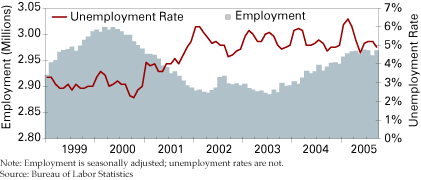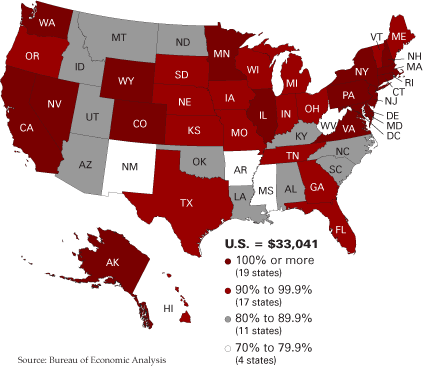Indiana
Indiana Business Research Center, Kelley School of Business, Indiana University
Taking stock in the final quarter of 2005, Indiana’s economy has continued to grow during the past year, though its rate of growth is slowing down as the year draws to a close. As shown in Figure 1, the state’s total nonfarm employment has recouped much of its losses from the first few years of this decade. In fact, in September 2005, total employment was only 45,000 below its all-time high of 3,013,800 reached in May 2000. This represents a gain of 83,700 jobs since the state’s employment bottomed out in July 2003.
Figure 1
Indiana’s Monthly Nonfarm Employment and Unemployment Rate

Since the start of 2005, Indiana employment has averaged about 40,000 more jobs than a year earlier. However, much of that growth occurred in the early months of this year—since April, year-over-year growth has averaged a little over 34,000 jobs; and for the third quarter, employment was up only about 29,000 more jobs than a year earlier.
Indiana’s employment gains have come more from some sectors than others, and the pattern of sectoral growth seems to be shifting. Education and health services continues to lead the charge with a gain of 9,100 jobs in the past twelve months. Leisure and hospitality has maintained a steady second position this year, up by 6,000 jobs. The fluctuating professional and business services sector has experienced weakening growth this year, slowing considerably in the last several months to around 4,000 jobs more than a year earlier, compared to gains of around 11,000 jobs earlier in the year.
Construction has remained strong throughout 2005, averaging about 5,000 more jobs than a year earlier. Trade, transportation, and utilities, which has employed slightly more Hoosiers than manufacturing for the past few years, also showed solid growth in 2005, with an increasing pace evident the last half of the year.
Manufacturing, the sector in which Indiana still leads the nation as a percentage of total employment (19.2 percent), continues to struggle. Manufacturing employment was down in September by 2,200 jobs compared to a year earlier, and down by 5,100 jobs compared to its post-recession peak in March.
Indiana’s unemployment rate has meandered around 5 to 6 percent for nearly four years. For most of 2005, the rate has been slightly above 2004 levels, but the year is closing in on a level close to the end of last year.
Other Indicators
The pulse of a state’s economy is measured by more than just employment statistics. Indiana’s gross state product (GSP) ranks fifteenth nationally, as it has for many years, and is the broadest measure of total output of a state’s economy. However, the rate of growth in GSP since 2000 (a 7.1 percent gain) ranks Indiana forty-fourth among the states. Indiana’s per capita personal income, which reflects individual earnings from all sources, has slipped to only 91 percent of the national average, below two-thirds of the states (see Figure 2).
Figure 2
Per Capita Personal Income as a Percent of the U.S. Total, 2004

Indiana’s Outlook for 2006
Several factors combine to complicate prediction of Indiana’s economic outlook. The American auto industry is struggling, weakening demand for the products of many Indiana firms, especially manufacturers. This could take a toll on the state’s steel industry, too, although mills supplying foreign customers or the construction industry may do well. Moreover, even if housing demand begins to level off, demand for Indiana appliances and other goods used in residential construction should hold its own.
Indiana farmers are expected to face a challenging year ahead as costs of production rise faster than farm prices, but some anticipate increasing demand as they target the biofuels industry. Hoosier consumers are entering the winter heating season with the prospect of record-high fuel bills, especially for those heating with natural gas. Coupled with persistent high gasoline costs, consumers may be less inclined to spend money in Indiana stores and restaurants.
The overall outlook suggests that Indiana’s economy will experience moderate growth in 2006, but that the growth will be unevenly distributed across the economy. Especially in light of recent announcements of plant closures and layoffs, Indiana manufacturing jobs are not likely to grow, though they may hold their own as more competitive firms expand in selected industries. Job growth in Indiana is expected in health and education services, construction, trade and transportation, and leisure and hospitality. Overall employment should expand in 2006 by around 30,000, possibly even clearing the 3 million mark. The state unemployment rate should finish the year down slightly from its current level to around 4.8 percent.
Also in this Issue…



